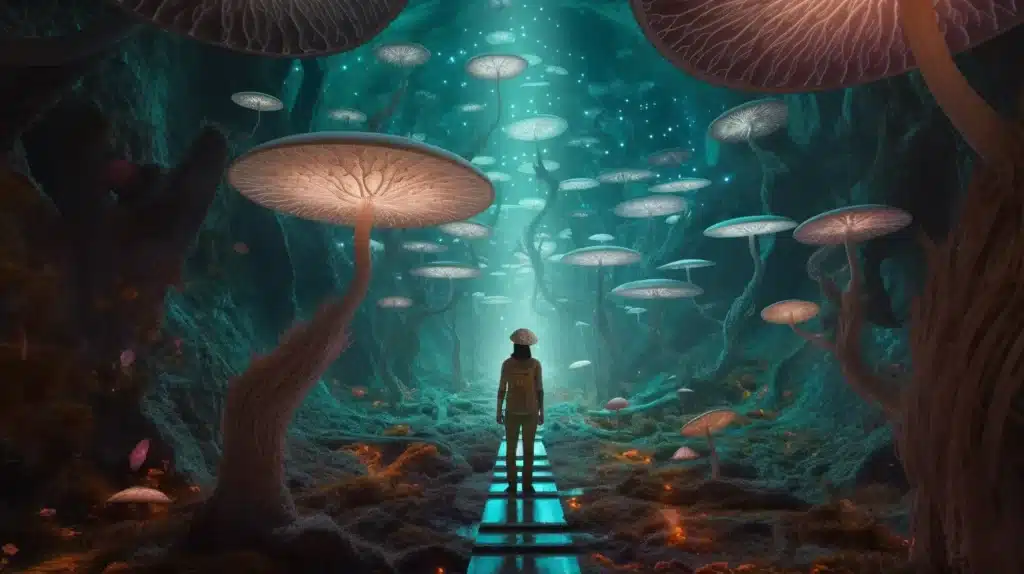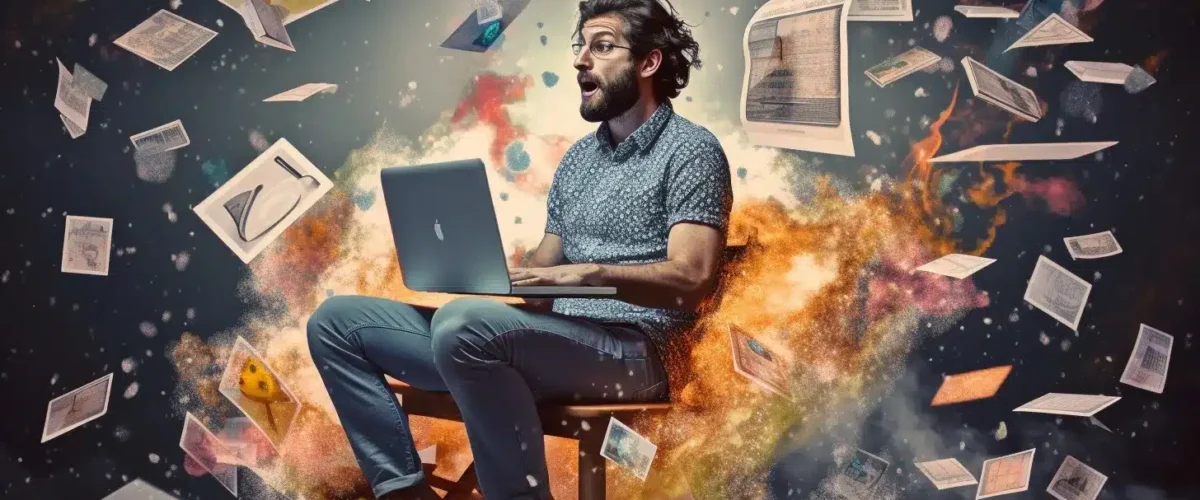The Rise of AI Content: Tackling the Content Boom and Its Implications
One of the things the ongoing artificial intelligence revolution will bring us is a content explosion. We will witness exponential growth in quality written and visual content.
This can roll out in a variety of ways, but let’s explore a few scenarios of how would it happen and what are the implications of such an explosion.
What are the Phases of Content Explosion?
I’ve been thinking about it a bit, and here’s a likely four-phase scenario of how this explosion will come about.
Early adoption
This is the first phase of content explosion. This is the step where people become aware of the power of generative AI. A few tech enthusiasts (such as myself) will experiment with it and try to streamline its services in their life and work.
AI begins to assist writers, journalists, visual artists, music producers, and other content creators in generating ideas, automating repetitive tasks, and generating higher-quality work.
This phase brings us a mild increase in content being created, as creators themselves will become faster in putting it out. Complex creations can be released in fewer steps and less work, so it’ll also make content quality increase.
Mainstream adoption
As AI-powered tools become more accessible and affordable, mainstream users begin to adopt generative AIs into their lives.
This leads to a significant increase in content production across various platforms, including social media, blogs, videos, and other multimedia content.
The quality of AI-generated content improves further, and the distinction between human-generated and AI-generated content begins to blur.
Many innovative organizations will also embrace AI. They’ll be needing less workforce to create the same or more value for their shareholders. The companies that are slower to integrate will get dissolved.
Hyper-production
In this phase, AI-generated content explodes exponentially. AI tools become capable of producing high-quality content rapidly and at scale.

This leads to a massive increase in the volume of content available, making it difficult for users to differentiate between high-quality and low-quality content.
Information overload and content saturation will become major challenges, and content discovery, curation, and filtering become increasingly important.
At this stage no audiovisual content can be trusted. We also lose the ability to judge if a piece of content is real or fake or if it’s created with ill intentions.
As a thought exercise, imagine scam emailers from Nigeria becoming indistinguishable from real businessmen.
Adoption
In response to the challenges posed by the content explosion, new tools and strategies emerge to help users navigate and make sense of the vast amounts of content.
AI-driven curation, personalization, and filtering tools become essential, and content platforms adapt to better accommodate users’ needs.
In this phase, users, creators, and platforms alike focus on quality over quantity, and a new balance is established between human-generated and AI-generated content.
Potential Risks of Content Explosion

As the future is uncertain, any of the phases mentioned above can become awry at any point in time.
Will the adoption phase be quick enough to prevent worldwide distrust chaos and takeover of governments and organizations by ill-minded power-hungry individuals?
I guess only time will tell, but what we can do, is look at the potential risks a content explosion has on society and individuals.
Job Displacement
As generative AI becomes more advanced, it has the potential to replace human content creators in certain industries. This could lead to widespread job loss and will surely lead to big changes in the overall economic climate.
More on job displacement problems (and solutions) here https://teemusk.com/ai-revolution-and-job-loss/
Mental health and well-being
The constant exposure to an overwhelming amount of content can lead to information overload and anxiety. The fact that no content can be trusted makes it even worse.
This could negatively impact mental health, contributing to stress, depression, and reduced quality of life for all.

Loss of Privacy
Advertising will become extremely efficient by becoming ultra-personalized targeting our preferences and vulnerabilities.
Phishing attacks and social engineering will become much more efficient. Deepfakes become so convincing that humans can be fooled to believe anything.
Imagine talking to an AI-powered scammer over the phone who sounds and acts exactly like your spouse having an emergency.
Disinformation and Propaganda
As generative AI becomes more advanced, it will become easier to create fake news, deep fakes, and other forms of disinformation and propaganda.
This will lead to widespread distrust in media and further erosion of truth and democracy.
Soon, it’ll be way more difficult to choose which content to believe in and information bubbles will have thicker walls (read more about information bubbles https://teemusk.com/information-bubbles/).
Copyright Infringement
Generative AI can be used to create content that infringes on the copyright of others, leading to legal disputes and financial loss for creators.
It’s a thin line and as we know, content creators are already accusing AI companies of their creation misuse (https://www.reuters.com/legal/transactional/lawsuits-accuse-ai-content-creators-misusing-copyrighted-work-2023-01-17/)
Information Bias
Like all machine learning models, generative AI can be trained on biased data, leading to biased outputs.
It’s a bit of a paradox — programmers, like me, are going to use fewer and fewer sites like Stack Overflow (https://stackoverflow.com/) when searching for guidance. This means less content is being added to this site and Q&A of common questions will be disposable.
However, if AI is now trained with data from such sites, it’ll become biased quite quickly.
Above are some of the risks of content explosion. Humans and society are unpredictable. If under enough pressure and manipulation, us vs. them mentality can increase leading to civil unrest and even wars.
Positive sides of Content Explosion
As there are two sides to every mirror, content explosion and generative AI can make good things happen for us as well.
Increased Efficiency
Generative AI can produce content at a much faster pace than humans, which could lead to increased efficiency in quality content creation.
Anything can be created faster. This minimizes the time and labor put into writing a novel or creating a painting that will change the way we understand or see the world.
Bigger projects can be undertaken with smaller budgets. Anyone with a good enough script can ‘generate’ a movie.
Enhanced Creativity
Generative AI can provide new and novel ideas that human creators may not have thought of, leading to enhanced creativity in content creation.
Artists need to experiment to be innovative. By making experimentation easier and faster AI will help them to come up with creative new ideas.

Accessible Content Creation
Generative AI can make quality content creation more accessible to people who may not have the resources or skills to create content manually.
Everything we can imagine, we can create. This will bring us many new great artists and writers. The skills a creative genius lacks can be boosted with with a help of specialized AI.
Personalization
Generative AI will create content that is tailored to individual preferences, allowing for a more personalized user experience in all fields.
As much as it’s a risk, it’s also a positive side, as services and content will become much more efficient in giving everyone exactly what they need.
As an audiovisual creator myself, I can see so many ways AI can make the world more beautiful, experiences that we create more immersive, and the art space much more exciting than it is today.
How to ensure the positive scenario prevails?
There are many things we can do as an individual and as a society that can drive this train to a more positive outcome.
Education
We can educate people to become aware of the potential risks of content explosion. It’ll be ever more important that everyone can spot malicious content or a phishing scheme when they see it.
We should educate people to be aware of increasing stress levels and information overload and make sure every one of us will try to pop their information bubbles while its walls are nice and thin.
Ethical AI Development
There are two strong beliefs in this field; the first ones suggest, all AI systems should be closed and in close governmental control, while others think AI models should be open-sourced and available for all.
As a liberal, I believe in the latter and believe if we give equal opportunities to everyone, the good wins as it has throughout human history.
We can’t put the genie back into the bottle anymore, but we can have a discussion on how to make sure the AI models can be and are used ethically.
Encourage Human AI Collaboration
The more we encourage people to use AI the more people will understand how to make themselves more efficient with it. This way we will understand generative AI better. This in turn reduces many risks and helps make AI space more democratic, hopefully preventing dictators with too much power to emerge.
Invest in Content Curation Tools
To get to the adoption phase quicker, and prevent doomsday scenarios from happening, we should start thinking about making content curation and filtering systems more robust.
We should invest in tools that fact-check and detect false from the truth. The development of such filters and tools should be done hand in hand with the development of AI models.
Global Cooperation
We should strive to make AI available for everyone and collaborate in researching and developing AI models between all nations.
Governments could also collaborate on creating policies and regulations about its development and uses.
This would bring humanity closer on a global level and (hopefully) prevent violence-based wars from happening in the future. I have a feeling an AI can be an A-bomb-level, peace insurer in the world (not in fear, but in a positive sense).
With these steps and directions, we can make sure the control won’t get out of hand. That the negative effects would be minimal, and the positives will outweigh the bad.
Conclusion
We’re in the first phase of the content explosion at the moment. This means we ain’t seen anything yet. We just have people here and there experimenting and thinking about it. Some have raised an alarm, others admire how beautiful Midjourney’s images are.
There are several risks to powerful generative AIs and the magnitude of change now is inevitable. Genie truly is out of the bottle.
I hope to raise awareness about such things by sharing my musings here.
Please let me know if you agree or disagree with some of the ideas in this article and let’s discuss this stuff. I’m confident that by working together we can make sure the future will be positively empowered by Artificial Intelligence.
I’m an iOS developer and a leader of a small development shop that does WordPress and mobile app development. Contact me on social media and let’s work together.


